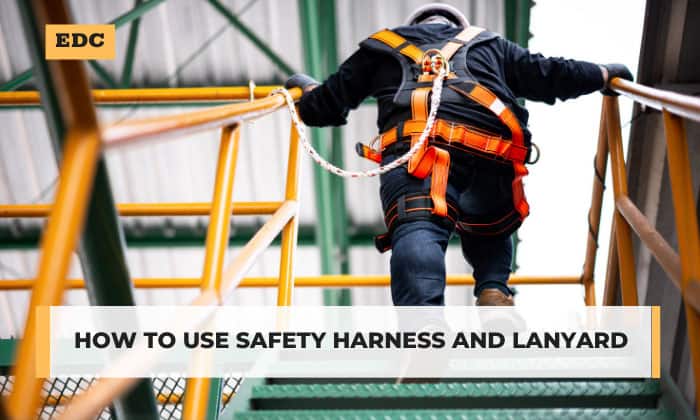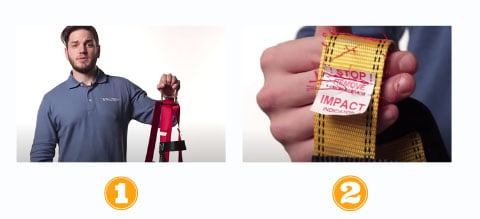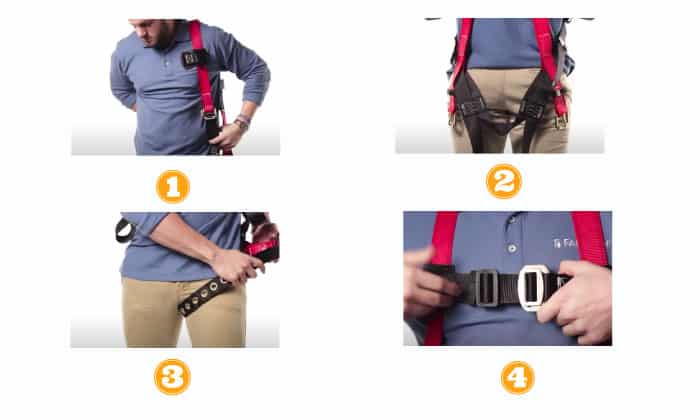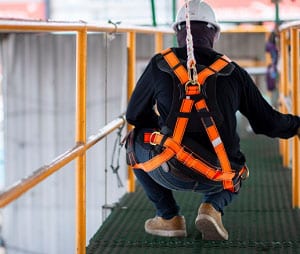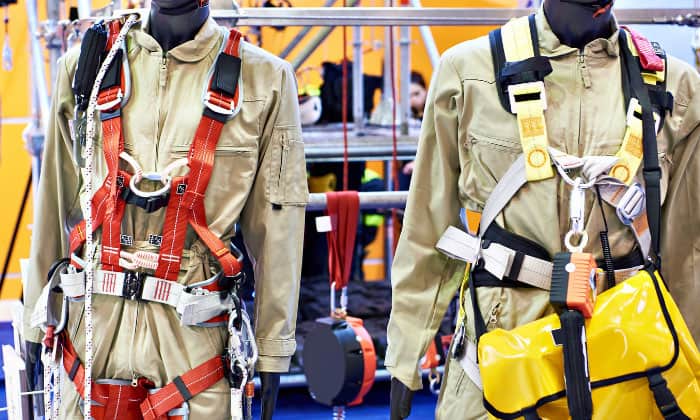Using a safety belt to catch a fall is now a thing of the past. Whether it’s a window cleaning service or construction, employees are now required to use personal fall arrest systems or PFAS. Besides keeping the user from hitting the ground, these devices prove to be useful in accessing a tight space or performing tasks on elevated surfaces.
But while these systems can keep you safe, they can harm you if you use them improperly or skip inspections. Let’s explore how to use safety harness and lanyard correctly so you don’t run into trouble.
Table of Contents
Step-by-step Guide on Using Safety Harnesses and Lanyards
What to prepare
- Safety harness
- Lanyards
- Inspection checklist
Note: Be sure that your lanyard and harness are suitable for the job. If you’re unsure, refer to the FAQ section to learn more about the different harnesses and lanyards available in the market.
1. Putting on the safety harness
Step 1: Grab the harness by the dorsal D-ring and check its components
- Lift your harness by grabbing its dorsal D-ring. Then, shake it to unbraid its webbings. Make sure to undo all the buckles.
- Conduct a visual and touch check on every part of the harness, including hardware, webbings, stitchings, and tags.
Remove the harness from service if you see the following:
- Signs of malfunction and damage due to impact or overuse
- Previously involved in arresting a fall
- Past its expiration date
- Unreadable tags
Step 2: Put on the safety harness
- Find the shoulder straps and slip your arms through them.
- Position the dorsal D-ring between the shoulder blades and the sub-pelvic strap just below your buttocks. You can lengthen or shorten the straps if needed.
- Fasten the buckles of the leg straps and adjust the straps to fit each leg tightly without cutting off blood flow.
- If your harness comes with a waist strap, now is the time to buckle it. Then, connect the chest strap. Ensure that it rests tightly and squarely on the center of your chest.
Read the detailed guide here: Step-by-step to Put on a Safety Harness Properly
2. Using a connecting device
Though there are plenty of lanyards that can be used for work, only a shock-absorbing lanyard for safety harness or a self-retracting lanyard (SLR) can arrest falls.
Choosing between the various designs of lanyards and SLRs will hinge on the type of job you need to do.
Once you have selected the connecting device, here are the next steps to take:
Calculate the required fall clearance at the job site by using a fall clearance calculator or adding up the following:
- Length of the lanyard
- Height of where the work takes place
- Deceleration distance
- Safety margin
Since each connecting device has unique requirements, check the manufacturer’s recommendations and instructions.
That said, let’s look at how connecting devices are used to give you a general idea:
- Lanyard – The lanyard must be connected to the deceleration device, lifeline, or anchorage on one end while the other is attached to the dorsal D-ring of the safety harness.
- SLR – The proper way to use a retractable lanyard is to affix the casing to a secure anchor point while the self-locking snap hook is attached to the harnessed worker.
FAQs
What is a lanyard?
Lanyards are either webbings, straps, or cords that come in various designs manufactured for several applications. Even the straps that we put on around our necks to hold an ID badge and keys are called lanyards.
But in industrial and recreational climbing, a worker uses a lanyard used for fall arrest and work positioning purposes is made of 3 feet or 6 feet heavy-duty webbings or cords with snap hooks or carabiners.
For fall restraint applications, a worker can use a safety belt with a lanyard to limit the distance they can travel. This way, they can stay away from the roof’s edge or areas where they can run the risk of falling.
Also read: Guide to using a roof safety harness properly.
Difference between a safety harness and a lanyard
The fall protection harness and lanyard are part of the same PFAS but they carry out different distinct functions.
As discussed previously, the harness is donned by the user. In the event of a fall, it can distribute the arresting force across the user’s body and support the weight.
Meanwhile, the purpose of a lanyard is to connect the user to the anchorage. During a fall, it is supposed to absorb the energy to minimize the force applied to the worker’s body and anchor. However, it cannot bear the weight of the user.
Different types of safety harnesses and lanyards
5 types of safety harnesses
1. General fall arrest harness
General fall arrest harnesses are the simplest among all types as they only have one dorsal D-ring. Some models may come with a sternal D-ring in addition to the dorsal D-ring.
2. Work positioning harness
Work positioning harnesses have about three or four attachment points. Besides the dorsal, the other D-rings are typically located around the hips to keep the wearer’s body in place.
3. Confined space or retrieval harness
With one shoulder D-ring on each shoulder, the confined space and retrieval harnesses are used for rescue operations. The design ensures that the rescuee remains upright.
4. Descent, suspension, and rigging harness
Equipped with one sternal D-ring, descent harnesses work together with other descent control devices.
On the other hand, suspension or rigging harnesses feature one sternal D-ring and additional side D-rings to support and position the worker while suspended.
5. Special material harness
What sets this harness apart is that it is made of Kevlar or Nomex and coated hardware to shield the welders against arch flashes.
4 types of lanyards
1. Self-retracting lanyard or lifeline (SLR):
This deceleration device has a drum-wound line and a mechanism that allows the line to be extracted without slacking. But during the fall, it instantly locks the drum to prevent the user from falling further down and hitting the ground.
2. Shock-absorbing lanyard
Thanks to its shock-absorbing qualities, this lanyard helps reduce the arresting force to 900 lbs or less. An essential component of a PFAS, it works hand-in-hand with the safety harness and is recommended for working at a height of over 6 feet from the ground.
3. Position lanyard
A position lanyard comes in a fixed length to hold the worker in place. It should not be used to arrest a fall.
4. Double tie-off lanyard or the Y-lanyard
The Y-lanyard is literally Y-shaped so that the user’s two legs can be connected to a snap hook and a shock absorber. Wearing a safety harness with a double lanyard like this enables the worker to traverse sideways at a height.
Where should lanyards be attached to harnesses?
Lanyards are connected to the attachment points of the harnesses called “D-rings.” Depending on each type, you can learn how to use a lanyard safely.
The number of D-rings differs from one type of harness to another, which may include either or all of the following:
1. Dorsal D-ring
To tie off a safety harness to a fall arrest system, a worker would hook up the lanyard at the D-ring found at the back and between the shoulder blades. Per OSHA’s recommendations, all fall arrest systems must have dorsal D-rings.
2. Sternal D-ring
Typically used for ladder or tower climbing applications, a sternal D-ring is located on the front of the harness, specifically at the chest level.
3. Shoulder D-ring
Shoulder D-rings are designed for temporary ladders. This is also appropriate for restraint and work positioning, which is why it is commonly used by rescuers and construction workers.
4. Side D-rings
A safety harness that features additional side D-rings on the waist that can be used for work positioning and supporting the worker when in suspension. This also allows them to work with their hands.
Keep in mind that side D-rings alone cannot arrest a fall. They are used together with a dorsal D-ring.
Conclusion
Granted, fall protection regulations and the way organizations implement them may vary in each country. However, just because your local authorities are more lenient doesn’t mean that you can cut corners with inspections or use whatever lanyard or harness you have. Remember, each type of connecting device and harness serves specific purposes.
Besides, the law of physics applies wherever you are on this planet. To quote Isaac Newton, “What goes up must come down.” Understanding the ins and outs of how to use safety harness and lanyard will help you calculate the risk and reduce it, if not eliminate it completely.

Veronica is our content editor. She is a talent in delivery. Her main work is editing and writing articles that are both informative and simple to follow. She is in charge of synthesizing our understanding of what personal protection equipment (PPE) is needed in each job, how to best apply it, and how to visualize that equipment.


